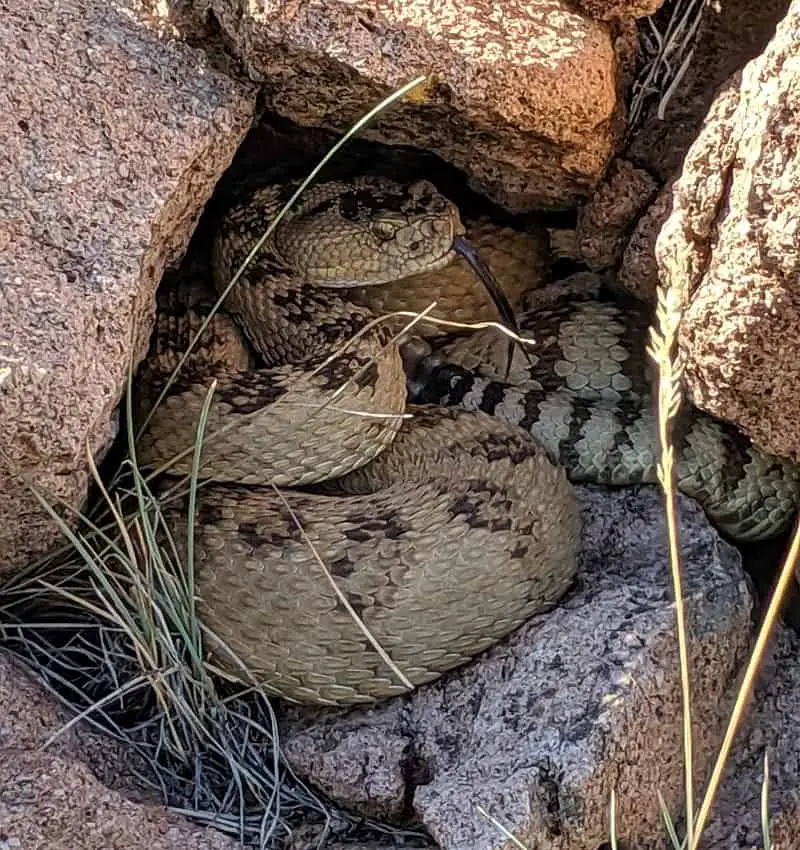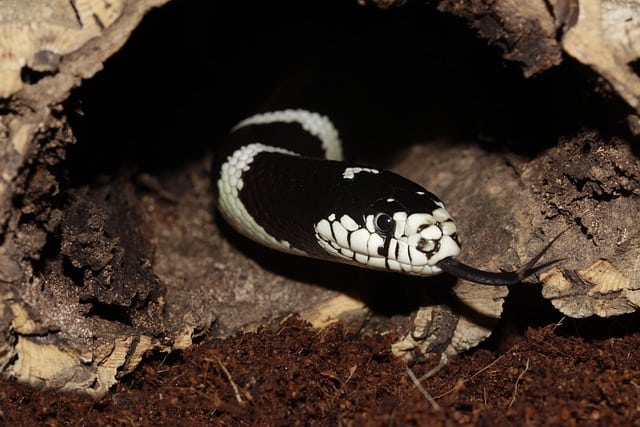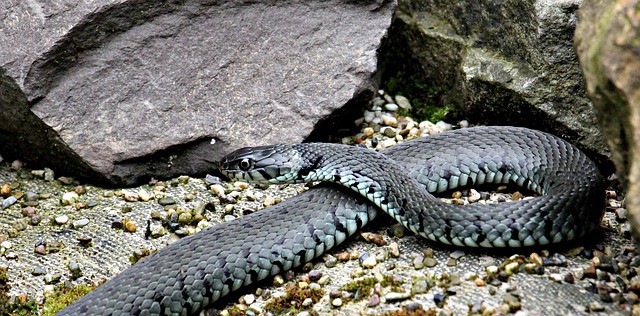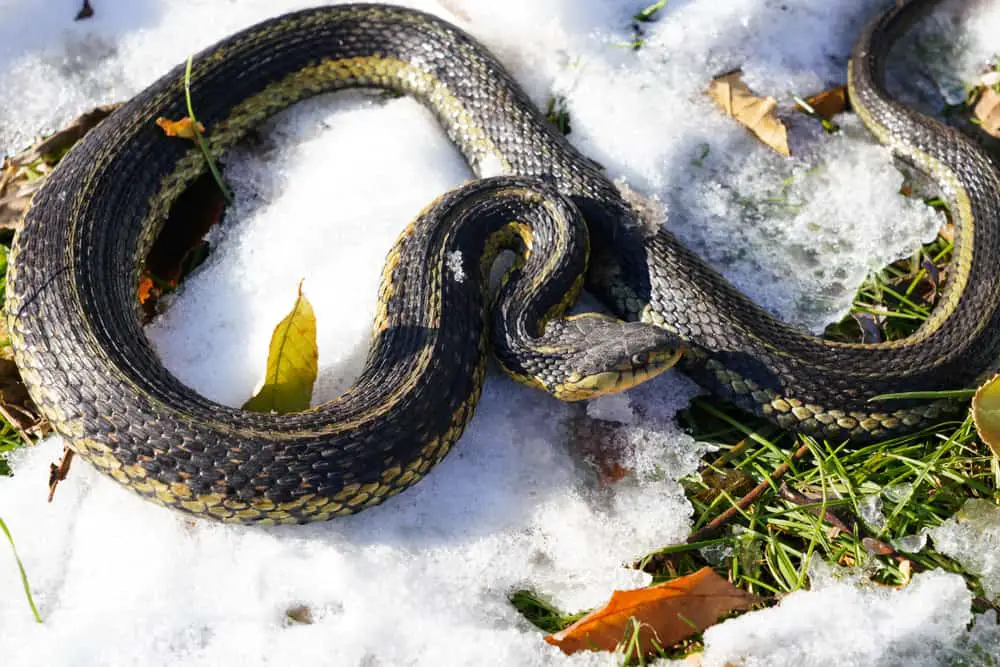Most of us know that bears hibernate during the cold winter months. To prepare for this, they spend the autumn months eating as much as they can, find a good safe den, and then go into a deep sleep until the colder weather passes. For these warm-blooded animals, this is the best way to survive the winter.
Meanwhile, most of us know that we don’t often see snakes during the winter, but we’ve never heard of snakes getting fat to prepare for the drop in temperature. So where are snakes all winter? Do they migrate to temperate climates? Are they hibernating with the bears? The answer is actually a fascinating one. They aren’t migrating. And they aren’t hibernating. But they are doing something close.
Do Snakes Hibernate?
Snakes do not hibernate, but they do brumate. This is similar to hibernation in that it’s a process to prepare for the winter, and they are more lethargic. However, for cold-blooded animals, the plan is nothing like what we know of bears and their habits.
A bear in hibernation will never leave their den.
Snakes in brumation will move slowly, which helps keep them warm and balance their metabolic rates. When it’s very cold out, they will stay in the same place where they’ve found a warm shelter. On winter days, when the sun is out, they will leave their shelter to lie on a warm rock in the light.
A bear in hibernation will eat a lot to fatten up before they go into a deep sleep for the duration of the cold weather.
A snake in brumation will not want to fatten up because that will slow its metabolic rates. Warm weather helps a snake’s digestive system, and cold weather slows its digestion down. If a snake goes into brumation with a stomach full of food, it won’t be able to process the food. They can actually die because the food will rot in their stomach. Because of this, as the weather gets colder, a snake will eat less. To prepare for brumation, they will build up their intake of glycogen (sugar). This keeps their muscles in good shape so they can be prepared to move around on sunny days or so they can seek out water. Even in the harsh cold, snakes will need to go out for water to avoid dehydration. They will usually find a warm home for the winter near a water source for this reason.
When Do Snakes Brumate?
For bears, the hibernation period solidly lasts all winter and can be fairly easily predicted. Depending on the region, bears will enter hibernation in mid-November or December, and for male bears, this will often last for five months.
Snakes brumate based on the average daytime temperatures, so they aren’t sticking to a particular time of year. In North America, it often gets a lot colder earlier in Alaska and Canada than it does somewhere further south, like Kansas. There are parts of the United States where they have species of snakes that start to show signs of brumation in late October, while in other areas, the cold months may not begin until later in December. As their body heat levels drop, snakes will naturally know to enter brumation, raise their glycogen levels, and take care of themselves.
How Long Do Wild Snakes Stay In Brumation For?
Snakes will stay in brumation while it’s cold. In cold climates, this could last for nine months. In some parts of the world, it may only be a few weeks. When temperatures get above 60 degrees Fahrenheit, they are likely to come out and enjoy the warmer weather again during the daylight hours. In much of North America, this means early spring.

Where Do Snakes Take Shelter While They Brumate?
Snakes will brumate anywhere they feel warm and safe. This will often mean that they take shelter under rock piles, tree stumps, or in spaces only a snake can reach. If there is a narrow opening, they can slither into deep crevices and find a warm space with enough cover, where snakes will make it their underground den. Ideally, they are looking for this space to be near water, since they will need to be able to get out and drink on warm days when they can to avoid dehydration.
Do Snakes Die During Brumation?
Yes. Snakes face a large number of dangers while they’re in brumation. During this time, they are slow-moving and more easily confused by predators. If another animal or human finds them while in brumation, they are easier to kill during this time.
On a warmer day, when a snake leaves their den to lie in the sun, the environmental temperatures may suddenly drop, and it may not have enough energy and body heat to safely get back to its shelter for the colder months. In this case, they may suddenly die.
They can also dehydrate if they don’t have the energy to find water or if a cold spell lasts too long and freezes their water source.
These are just a few examples of how a snake may die while they are more vulnerable during brumation. This is why it’s so important for them to find a good, safe, warm place to take shelter during this time.
Do Snakes Hibernate In Houses?
Generally speaking, humans like to avoid snakes, so it isn’t great to hear that a snake may find a space in or near your home to brumate. However, this definitely happens. When the outside temperature drops, your home is a heated space with a lot of good places for them to take shelter. Snakes often find crawl spaces, basements, garages, and the space below porches and deck stairs to be great spots for them to brumate. On a sunny day, they may venture out from beneath someone’s home and find that car engines are a great place for them to relax and raise their body heat.

How Can I Keep Snakes From Brummating On My Property?
Snakes are quiet and sneaky, so it’s common for them to go unnoticed on your property. They like hiding out under porches, tree stumps, and rock piles. If you want to take steps to keep snakes from choosing your property as their home, there are a few steps you can take to make your property less appealing for them.
The first step is to remove food sources that draw them in. Eliminating pests like rodents will discourage snakes from hanging out on your property.
Snakes need to brumate near water. Eliminate any standing water in your yard.
Unlike rodents, snakes aren’t going to chew their way into your home. If you want to keep snakes out of your house, spend some time in the fall double-checking around your home for anything that has fallen into disrepair and created an opening that a snake could fit through. Snakes are looking for easy access, and they are easily able to slither into very small spaces. If you’re able to keep your home tightly sealed, they’re unlikely to get inside.
Keeping your yard well-managed with low grass can help. Tall grasses are appealing to rodents and thus, snakes.
If you have wood piles in your yard, put them on a raised platform or in storage containers. This will keep the woodpile from becoming a friendly and warm space for snakes.
If you do find snakes in brumation on your property, it’s a good idea to contact a professional to remove them. They will have the right tools, and you will avoid discovering they’re actually venomous or simply biting you to try and protect themselves.
What Hikers Should Do If They Come Upon A Snake In Brumation
On a warm winter day, outdoor enthusiasts may come across snakes sunbathing on rocks or slowly moving across the trail as they seek out water and warmth. Some of these will be venomous snakes, and some won’t, but they’ll still be dangerous. A snake in brumation is aware that it is more vulnerable, so it’s going to be more protective of itself. While it’s moving slower, it can still definitely bite you. No matter the type of snake, it’s typically a good idea to leave a snake alone and let it take care of itself during brumation.

Do Pet Snakes Go Into Brumation?
Yes, pet snakes can go into brumation if they’re cold. If the temperature where your snake is living drops to 60 degrees Fahrenheit, then it may go into brumation. If this happens, you’ll likely notice them eating less and moving slower. To avoid having your pet snake go into brumation, many people will use a heat lamp to keep their snakes comfortably warm.
Do Snakes Brumate Together Or Alone?
Different species of snakes handle brumation differently.
Garter snakes are a great example. They are common across North America and generally considered harmless. Like all snakes, they may bite when they feel threatened, but they’re not venomous, and they aren’t hunting for humans to bite. Garter snakes will often find a large enough underground den to brumate together, which can help keep them safer and warmer.
Sometimes, different species of snakes will actually brumate together. This can sometimes be dangerous. For example, black racers have been known to kill rattlesnakes during brumation.
How Cold Does It Have To Be For Snakes To Enter Brummation?
The steady lowering of temperatures will gradually cue a snake to begin the process of brumation. Generally, most snakes will enter brumation in North America when temperatures get to 60 degrees Fahrenheit (16 degrees Celsius). Snakes prefer it to be above 65 degrees Fahrenheit to keep their body heat and metabolism at a healthy rate.
Snakes Don’t Hibernate, But They Do Take Precautions Against The Cold
For humans, the biggest difference between the way a snake brumates and a bear hibernates is that we may still see snakes even during the cold winter months. They’ll be sluggish and possibly confused as they go to find water or sunbathe, but they aren’t likely to be up to much else. Snakes prefer to do most of their hunting and breeding during the warm summer months, so you’re a lot more likely to spot them during that time.
Recent Posts
The only venomous snakes in Washington State are Northern Pacific Rattlesnakes. The Northern Pacific Rattlesnake (Crotalus oreganus oreganus) is a sub-species of the Western Rattlesnake. Anyone...
Skunks are not classified as true hibernators. But they go into a state of torpor when the weather gets cold. Skunks are light sleep hibernators, along with opossums, bears, and raccoons. ...

